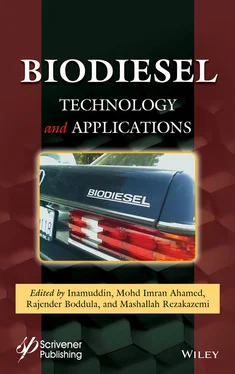1 ...8 9 10 12 13 14 ...24
1.7.1 Mechanisms of Lipase Action
Lipases interact with ester bonds of their substrate like acylglycerols to catalyze the reactions of hydrolysis, synthesis, and transesterification. Triglycerides, which are insoluble and long chained fatty acids, are precisely catalyzed by lipases [113]. Lipase carries out triglyceride oil transesterification with methanol in three reversible steps with the first step for conversion of triglycerides to diglycerides followed by the second step of diglycerides to monoglycerides conversion, and finally, monoglycerides convert into glycerol molecules. Here, each conversion step produces one FAME molecule; hence, a total of three FAME molecule are produced from one triglyceride [116]. Two models are mainly under discussion to describe the kinetics mechanism for esterification reactions, Michaelis-Menten kinetics and Ping Pong Bi Bi model. Lipase catalyzed esterification mainly elaborated by Ping Pong Bi Bi mechanism which is a bi-substrate reaction that releases two products. It involves following steps: 1) acyl-donor donate their acyl group to the enzyme resulting in the formation of acyl-enzyme complex, 2) release of the water molecule as a product, 3) binding of acyl acceptor with the enzyme complex, and 4) release of ester [117, 118]. Many researchers made some modifications in this model depending upon inhibiting factors [118]. The catalytic activity begins with the transient tetrahedral intermediate formation with a negatively charged carbonyl oxygen atom. The reaction between the hydroxyl group oxygen present in nucleophilic serine residue of lipase enzyme and activated carbonyl carbon of the substrate involved building this transient tetrahedral intermediate. The intermediate thus formed is stabilized by its interaction with two peptide NH groups. After that nucleophilic hydroxyl group of water react with the carbonyl carbon of acyl-enzyme complex resulting in the formation of acyl product and enzyme is released for further catalysis [119].
1.7.2 Efficient Lipase Sources for Biodiesel Producing Biocatalyst
Lipases can be obtained from plants, animals, and microorganisms and based on that lipases can be classified on it as plant, animal, and microbial lipases depending on their origin respectively. Lipases from different sources with different structure has different properties and catalytic activities. We can use this to counter lipase problems in biodiesel production like lipase cost and methanol inhibition. We need to optimize reaction conditions according to chosen substrate and lipase from specific source [107]. Microbial lipases are widely used at industrial and commercial level as biocatalysts for biodiesel production because microbial lipases are more stable and can be produced in bulk amount from microorganism [23]. Microbial lipases can be manipulated genetically with ease, seasonal changes have nothing to do with lipase production, and rapid growth of microbes makes them the ideal candidates as lipase source [120, 121]. Use of microbial lipase is increasing day after day and currently 5% of the world enzyme market is being shared with microbial lipases [121]. Microbial lipase weighs around 30–50 kDa and their optimum pH to work at is 7.5. Based on temperature tolerance, microbial lipases can be categorized as mesophilic and thermophilic lipases. Mesophilic lipases normally work at 35°C–50°C and they become denature above 70°C while thermophilic or thermostable lipases normally work at 60°C–80°C, but some also work at 100°C under specific conditions [122, 123]. According to Hotta et al . [123], lipases from Pyrobaculum calidifonti (hyperthermophilic archae) showed its activity at 90°C. Similarly, thermostable lipases from Caldanaerobacter subterraneus and Thermoanaerobacter thermohydrosulfuricus (highly thermophilic bacteria) performed well in the range of 40°C–90°C. They not only performed well at high temperatures but also were resistant toward organics solvents [124]. Lipase producing microorganisms can be isolated from soil, waste water, marine water, and industrial wastes. Isolates of Mucor , Sclerotina , Candida , and Aspergillus strains have been reported, which were isolated from soil. Similarly, various strains of microbes such as P. alcaligenes , Bacillus acidophilus , Enterobacter intermedium , P. fluorescens , and Geotrichum asteroids are also reported as lipase producing strains when isolated from vegetable oil processing plants [141]. Screening of microbes is done by checking their lipolytic. Generally, lipases are screened using batch cultures having agar as substrate but this is time consuming. So, the two mostly used methods for lipase production are solid state fermentation and using submerged culture [142]. Purified form of lipases is used in biochemical reaction to get maximum benefit from it, so purification is required. Purification of lipase requires several techniques including ammonium sulfate precipitation or ultrafiltration and after that more sensitive and advanced techniques are utilized like gel filtration, ion exchange chromatography, and affinity chromatography [143]. Moreover, some other novel techniques can also be applied to purify lipases such as immunopurification, column chromatography, hydrophobic interaction chromatography, and membrane process. Generally, the strategy used for purification lipases starts with the removal of lipase producing cells from their growth culture to get extracellular lipases after fermentation. Then, the extract without cells is concentrated by organic solvents, ultrafiltration, and precipitation using ammonium sulfate. Ammonium sulfate precipitation is used in the first stages of purification and it crudely separate out things from mixture. After that advanced techniques of chromatography are used to finely purify lipases [144]. According to Javed et al . [112], diverse data from various research work suggested that purification had been done from 2.4 to 500 folds with an increase in yield from 10.3% to 36%. Effective production and purification strategies of lipases are being designed to get maximum yield at a very small expense. Among microbial lipases, the most commonly used lipase sources are bacteria, fungi, yeast, and algae; see Table 1.1for some bacterial lipases and Table 1.2. for fungal lipases that are used for biodiesel production [46]. Some of the commercially available enzymes for biodiesel production are enlisted in Table 1.3.
1.8 Comparative Analysis of Intracellular and Extracellular Lipases for Biodiesel Production
Transesterification reaction for biodiesel production is done with both extracellular and intracellular lipases. Preference for their use is dependent upon either we want simple upstream processes as in case of intracellular lipase or high enzymatic conversion as in case of extracellular lipase. But either we use intracellular lipase or extracellular lipase there is no need for some downstream processes including separation and recycling. Further, both immobilized lipase (extracellular) and immobilized whole-cell lipase (intracellular) are proved to have highly efficient when compared with free lipase used for transesterification [165]. Some experimental studies for both intracellular and extracellular lipases are given in Table 1.5. Intracellular lipases are the enzymes present inside the cells or linked to the walls of cells producing it known as whole-cell biocatalysts. They are not purified or separated from their cells and used as a whole-cell for transesterification (whole-cell biocatalyst) or immobilized (whole-cell immobilization) [55]. Rhizopus and Aspergillus which are filamentous fungi are most widely used as whole-cell biocatalyst for transesterification process [166]. As the main issue related to biodiesel production at large scale is cost and the use of intracellular lipase for transesterification resolves this problem like the use of intracellular lipase is considered cost-effective because of the elimination of costly processes of lipase isolation and purification before immobilization which are required in case of extracellular lipase [167]. Intracellular lipase producing cells or whole-cell biocatalysts are directly employed for immobilization without separation and purification steps for lipase enzymes [55]. Porous biomass support particles (BSPs) are mostly used for whole-cell immobilization. BSPs was developed by Atkinson et al . [168] and used by many scientists and each scientist provide an efficient way of immobilization on it giving out a high yield of biodiesel. A study to check the lipolytic activities of Bacillus species using intracellular as well as extracellular lipase showed higher intracellular lipase activity than extracellular lipase activity [169]. Reported whole-cell biocatalysts are A sp ergillus oryzae , Burkholderia cepacia , filamentous fungus Rhizopus chinensis , R. oryzae , and Enterococcus faecium [170–174]. A sp ergillus oryzae used as whole-cell biocatalyst exhibited 98.1% relative stability after the fourth batch and produced more than 97% FAME in 32 hours. Extracellular lipases are the purified form mainly fungal and bacterial cells for their use in transesterification process.
Читать дальше












